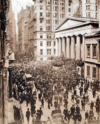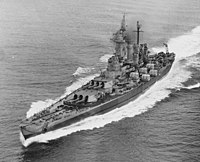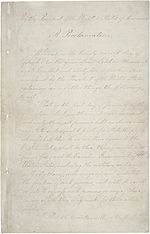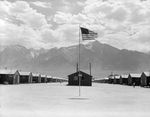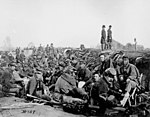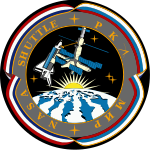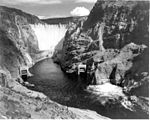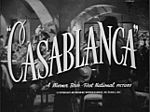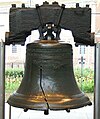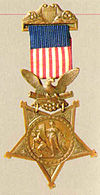Portal:United States/Selected article
historical reference. This page has been replaced with an automatically updated list of featured articles at Portal:United States/Recognized content . |
Selected article
</noinclude>
Instructions
- Use template {{Portal:United States/Selected article/Layout}}.
- Add a new Selected article to the next available subpage.
Selected articles list
1–25
Selected article 1
</noinclude> Portal:United States/Selected article/1 The
Selected article 2
</noinclude> Portal:United States/Selected article/2
TheThe GSUSA uses the Scout method to build self-esteem and to teach values such as honesty, fairness, courage, compassion, character, sisterhood, confidence, and citizenship through activities including camping, community service, learning first aid, and earning numerous badges by acquiring other practical skills. Girl Scouts' achievements are recognized through rank advancement and by various special awards. GSUSA has programs for girls with special interests, such as water-based activities.
Membership is organized according to age group with activities designed appropriately for each level. The GSUSA is a member of the World Association of Girl Guides and Girl Scouts (WAGGGS), and has a long history of accepting girls from all backgrounds.
Selected article 3
Selected article 4
</noinclude> Portal:United States/Selected article/4
Aside from visits by
Yellowstone National Park spans an area of 3,472 square miles (8,987 km²), comprising lakes, canyons, rivers and mountain ranges. Yellowstone Lake is one of the largest high-altitude lakes in North America and is centered over the Yellowstone Caldera, the largest supervolcano on the continent. Half of the world's geothermal features are in Yellowstone, fueled by this ongoing volcanism. The park is the centerpiece of the Greater Yellowstone Ecosystem, the largest remaining, nearly-intact ecosystem in the Earth's northern temperate zone.
Hundreds of species of mammals, birds, fish and reptiles have been documented. The vast forests and grasslands also include unique species of plants.
Selected article 5
</noinclude> Portal:United States/Selected article/5
The North Carolina class was a group of two fast battleships, North Carolina and Washington, built for the United States Navy in the late 1930s and early 1940s. The navy was originally uncertain whether the ships should be fast enough to counter the Japanese Kongō class, which was believed by the United States to be capable of 26 knots (30 mph; 48 km/h), or should sacrifice speed for additional firepower and armor. The Second London Naval Treaty's requirement that all capital ships have a standard displacement of under 35,000 long tons (35,560 metric tons (t)) meant that the desired objectives could not be fully realized within the treaty limits, and the navy considered over fifty designs before one was chosen.Both North Carolina and Washington saw extensive service during World War II in a variety of roles, primarily in the Pacific theater. North Carolina frequently acted as an escort for the fast carrier task forces, and also conducted shore bombardments. In 1942, during the
Selected article 6
</noinclude> Portal:United States/Selected article/6
It is these peoples, who in the past were referred to and self-identified collectively as the American Negro, who now generally consider themselves African Americans. It is these peoples whose history is celebrated and highlighted annually in the United States during February, designated as Black History Month, and it is their history that is the focus of this article.
Others who sometimes are referred to as African Americans, and who may self-identify as such in US government censuses, include relatively recent Black immigrants from Africa, South America and elsewhere who self-identify as being of African descent.
Selected article 7
</noinclude> Portal:United States/Selected article/7
TheThe 50 stars on the flag represent the
Because of its symbolism, the starred blue canton is called the "union". This part of the national flag can stand alone as a maritime flag called the Union Jack[3] which served as the U.S. jack on warships from 1777 until 2002. It continues to be used as a jack by various federally-owned vessels, including those of the Coast Guard, Military Sealift Command, and National Oceanic and Atmospheric Administration.
Selected article 8
</noinclude> Portal:United States/Selected article/8
Founded by a group of
Plymouth holds a special role in American history. Rather than being entrepreneurs like many of the settlers of Jamestown, the citizens of Plymouth were fleeing religious persecution and searching for a place to worship God as they saw fit. The social and legal systems of the colony were thus closely tied to their religious beliefs. Many of the people and events surrounding Plymouth Colony have become part of
Selected article 9
</noinclude> Portal:United States/Selected article/9
Long before the first prisoners arrived in March 1942, Manzanar was home to
Selected article 10
</noinclude> Portal:United States/Selected article/10
TheSeveral of the ideas in the Constitution were new, and a large number of ideas were drawn from the literature of
Selected article 11
</noinclude> Portal:United States/Selected article/11
TheHostilities began on April 12, 1861, when Confederate forces attacked a U.S. military installation at
In the East, Confederate commander
The war caused 620,000 soldier deaths and an undetermined number of civilian casualties, ended
Selected article 12
</noinclude> Portal:United States/Selected article/12
7 World Trade Center (7 WTC, WTC-7, or Tower 7) is an office building constructed as part of the new World Trade Center in Lower Manhattan, New York City. The tower is located on a city block bounded by Greenwich, Vesey, Washington, and Barclay Streets on the east, south, west, and north, respectively. 7 World Trade Center was developed by Larry Silverstein, who holds a ground lease for the site from the Port Authority of New York and New Jersey, and designed by Skidmore, Owings & Merrill.The building was constructed to replace the original structure on the site, part of the original World Trade Center. The previous structure, completed in 1987, was destroyed in the September 11 attacks in 2001. Construction of the new 7 World Trade Center began in 2002 and was completed on May 23, 2006. The building is 52 stories tall (plus one underground floor), making it the 64th-tallest in New York. It is built on a smaller footprint than the original; a small park across Greenwich Street occupies space that was part of the original building's footprint.
The current building's design emphasizes safety, with a reinforced concrete core, wider stairways, and thicker fireproofing on steel columns. It also incorporates numerous green design features. The building received the U.S. Green Building Council's Leadership in Energy and Environmental Design (LEED) Gold certification and was part of the council's pilot program for Leadership in Energy and Environmental Design – Core and Shell Development (LEED-CS). (Full article...)
Selected article 13
</noinclude> Portal:United States/Selected article/13
TheThe project, sometimes called "Phase One", was intended to allow the United States to learn from Russian experience with long-duration spaceflight and to foster a spirit of cooperation between the two nations and their
During the four-year program, many firsts in
The program was marred by various concerns, notably the safety of Mir following a fire and a collision, financial issues with the cash-strapped Russian Space Program and worries from astronauts about the attitudes of the program administrators. Nevertheless, a large amount of science, expertise in space station construction and knowledge in working in a cooperative space venture was gained from the combined operations, allowing the construction of the ISS to proceed much more smoothly than would have otherwise been the case.
Selected article 14
</noinclude> Portal:United States/Selected article/14
TheThe statue was administered by the United States Lighthouse Board until 1901 and then by the Department of War; since 1933 it has been maintained by the National Park Service. The statue was closed for renovation for much of 1938. In the early 1980s, it was found to have deteriorated to such an extent that a major restoration was required. While the statue was closed from 1984 to 1986, the torch and a large part of the internal structure were replaced. After the September 11 attacks in 2001, it was closed for reasons of safety and security; the pedestal reopened in 2004 and the statue in 2009, with limits on the number of visitors allowed to ascend to the crown. The statue is scheduled to close for up to a year beginning in late 2011 so that a secondary staircase can be installed. Public access to the balcony surrounding the torch has been barred for safety reasons since 1916.
Selected article 15
</noinclude> Portal:United States/Selected article/15
The war ended with the total victory of the Allies over Germany and Japan in 1945. World War II altered the political alignment and social structure of the world. The United Nations (UN) was established to foster international cooperation and prevent future conflicts (such as World War III). The Soviet Union and the United States emerged as rival superpowers, setting the stage for the Cold War, which would last for the next 46 years. Meanwhile, the influence of European great powers started to decline, while the decolonization of Asia and Africa began. Most countries whose industries had been damaged moved towards economic recovery. Political integration emerged as an effort to stabilise postwar relations.
Selected article 16
</noinclude> Portal:United States/Selected article/16
The knownEarly residents soon realized that
Selected article 17
</noinclude> Portal:United States/Selected article/17
Hoover Dam impounds
Selected article 18
</noinclude> Portal:United States/Selected article/18
Composing a
Selected article 19
</noinclude> Portal:United States/Selected article/19
Although it was an A-list film, with established stars and first-rate writers—
Selected article 20
</noinclude> Portal:United States/Selected article/20
"Amazing Grace" is a Christian hymn written by English poet and clergyman John Newton (1725–1807), published in 1779. With a message that forgiveness and redemption are possible regardless of the sins people commit and that the soul can be delivered from despair through the mercy of God, "Amazing Grace" is one of the most recognizable songs in the English-speaking world.Newton wrote the words from personal experience. He grew up without any particular religious conviction but his life's path was formed by a variety of twists and coincidences that were often put into motion by his recalcitrant insubordination. He was pressed into the Royal Navy and became a sailor, eventually participating in the slave trade. One night a terrible storm battered his vessel so severely that he became frightened enough to call out to God for mercy, a moment that marked the beginning of his spiritual conversion. His career in slave trading lasted a few years more until he quit going to sea altogether and began studying theology.
Author Gilbert Chase writes that "Amazing Grace" is "without a doubt the most famous of all the folk hymns", and Jonathan Aitken, a Newton biographer, estimates that it is performed about 10 million times annually. It has had particular influence in
Selected article 21
</noinclude> Portal:United States/Selected article/21
Selected article 22
</noinclude> Portal:United States/Selected article/22
Less than 35 minutes into the flight, the hijackers stormed the cockpit and forced the passengers to the rear of the aircraft. Hani Hanjour, one of the hijackers who was trained as a pilot, assumed control of the flight. Unknown to the hijackers, passengers aboard were able to make telephone calls to loved ones and relay information on the hijacking.
The aircraft crashed into the western side of the Pentagon at 09:37 EDT. Dozens of people witnessed the crash and news sources began reporting on the incident within minutes. The impact severely damaged an area of the Pentagon and caused a large fire. A portion of the Pentagon collapsed; firefighters spent days trying to fully extinguish the blaze. The damaged sections of the Pentagon were rebuilt in 2002, with occupants moving back into the completed areas on August 15, 2002.
The 184 victims of the attack are memorialized in the Pentagon Memorial adjacent to the Pentagon. The 1.93-acre (7,800 m2) park contains a bench for each of the victims, arranged according to their year of birth, ranging from 1930 (age 71) to 1998 (age 3).
Selected article 23
</noinclude> Portal:United States/Selected article/23
TheSelected article 24
</noinclude> Portal:United States/Selected article/24
United Airlines Flight 93 was a scheduled U.S. domestic passenger flight from Newark International Airport, in Newark, New Jersey, to San Francisco International Airport. It was hijacked in 2001 by four men as part of the September 11 attacks. Over 40 minutes into the flight the hijackers breached the cockpit, overpowered the pilots and took over control of the aircraft, diverting it toward Washington, D.C. Several passengers and crew members made telephone calls aboard the flight and learned about the attacks on the World Trade Center and the Pentagon. As a result, the passengers decided to mount an assault against the hijackers and wrest control of the aircraft. The plane crashed in a field just outside Shanksville, Pennsylvania, about 150 miles (240 km) northwest of Washington, D.C., killing all 44 people aboard, including the hijackers. The plane fragmented upon impact, leaving a crater, and some debris was blown miles from the crash site. The remains of everyone on board the aircraft were later identified. Subsequent analysis of the flight recorders revealed how the actions taken by the passengers prevented the aircraft from reaching either the White House or United States Capitol. A permanent memorial is planned for construction on the crash site. The chosen design has been the subject of criticism and is scheduled to be dedicated in 2011.Selected article 25
26–50
Selected article 26
</noinclude> Portal:United States/Selected article/26
TheSelected article 27
</noinclude> Portal:United States/Selected article/27
TheSelected article 28
</noinclude> Portal:United States/Selected article/28
TheSelected article 29
</noinclude> Portal:United States/Selected article/29
TheSelected article 30
</noinclude> Portal:United States/Selected article/30
TheSelected article 31
</noinclude> Portal:United States/Selected article/31
The Leopold Report is a 1963 paper composed of a series of ecosystem management recommendations that were presented by the Special Advisory Board on Wildlife Management to United States Secretary of the Interior Stewart Udall. Named for its chairman and principal author, zoologist and conservationist A. Starker Leopold, the report proved influential for future preservation mandates and reports. After several years of public controversy regarding the forced reduction of the elk population in Yellowstone National Park, Udall appointed an advisory board to collect scientific data to inform future wildlife management of the national parks. The committee observed that culling programs at other national parks had been ineffective, and recommended management of Yellowstone's elk population. In addressing the goals, policies, and methods of managing wildlife in the parks, the report suggested that in addition to protection, wildlife populations should be managed and regulated to prevent habitat degradation. Touching upon predator control, fire ecology, and other issues, the report suggested that the National Park Service hire scientists to manage the parks using current scientific research. The Leopold Report became the first concrete plan to manage park visitors and ecosystems under unified principles. It was reprinted in several national publications, and many of its recommendations were incorporated into the official policies of the NPS. Although the report is notable for proposing that park management have a fundamental goal of reflecting "the primitive scene... a reasonable illusion of primitive America", some have criticized it for its idealism and limited scope.Selected article 32
</noinclude> Portal:United States/Selected article/32
TheSelected article 33
</noinclude> Portal:United States/Selected article/33
TheSelected article 34
Selected article 35
</noinclude> Portal:United States/Selected article/35
TheSelected article 36
</noinclude> Portal:United States/Selected article/36
Selected article 37
</noinclude> Portal:United States/Selected article/37
TheSelected article 38
</noinclude> Portal:United States/Selected article/38
The National Aeronautics and Space Administration (Selected article 39
</noinclude> Portal:United States/Selected article/39
TheSelected article 40
</noinclude> Portal:United States/Selected article/40
Selected article 41
Selected article 42
Selected article 43
Selected article 44
Selected article 45
Selected article 46
Selected article 47
Selected article 48
Selected article 49
Selected article 50
Nominations
Feel free to add FA-Class United States articles and A-Class United States articles, particularly of Top-, High- and Mid-Importance to the above list. GA-Class United States articles of Top- and High-Importance also may be preferred. Some articles of lower importance (or not listed under the U.S. project) also might be included as a way to improve the topical contents balance of the selections. Other United States-related articles may be nominated here as well.
United States popular pages by WikiProject
</noinclude> The following United States WikiProjects include lists of popular pages - the top pages ordered by number of views in the scope of each WikiProject.
| National | Superfunds
|
| States | |
| Borders | Canada | Mexico |
| Government | Government | Congress | Supreme Court cases |
| Culture | Military history | National Register of Historic Places |
| Society | African diaspora | Asian Americans | Indigenous peoples of North America |
Preferred articles
Potential articles
The following articles are of higher importance but lower quality. They might already be included here (![]() ) or otherwise have a good potential for inclusion with a little improvement. Some articles of lower importance and/or quality also might be included as a way to improve the topical contents balance of the selections.
) or otherwise have a good potential for inclusion with a little improvement. Some articles of lower importance and/or quality also might be included as a way to improve the topical contents balance of the selections.
- ^ States are represented collectively; there is no meaning to particular stars nor stripes.
- William Driver, a nineteenth century shipmaster.
- Union Flag of the United Kingdomto which this term more commonly refers.


